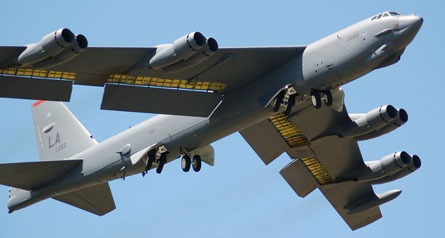US military officials are reviving plans for a sweeping electronic warfare modernisation strategy nearly three years after the US Air Force cancelled a stand-off jammer variant of the Boeing B-52, the centrepiece of the previous strategy.
Unlike the mostly discarded 2002 plan, dubbed the "airborne electronic attack system of systems" (AEA SOS), airborne platforms will not necessarily underpin the elements of the new strategy as it takes shape.
"We're trying to get rid of the term 'airborne electronic attack' because it creates such a narrow focus," US Navy Cdr J D McCreary, a director for the Joint Electronic Warfare Center, says.
 |
|---|
© USAF |
US Strategic Command has called for an analysis of a recent capabilities-based assessment for electronic warfare needs and gaps across air, land and surface forces, with a final report due on 1 April, McCreary says. "We need essentially to articulate how this relates to our national military strategy across all of our domains, all of our warfighting functions both material and non-material," he adds.
From that document will come the requirements for a new generation of electronic attack platforms and technologies, with the fate of several current airborne EW programmes hanging in the balance.
The AEA SOS led to the launch of Raytheon's Miniature Air-Launched Decoy-Jammer, which is now in development. But two other proposed concepts, including the stand-off B-52 Core Component Jammer (CCJ) and the stand-in Joint Unmanned Combat Air System were terminated in 2006.
Although Boeing and Northrop Grumman have continued to pursue the CCJ concept, it does not appear to have regained wider support since its cancellation.
"I think it's based on two things: fiscally constrained ends against risk and capabilities, and what do we do and where do we get the biggest bang for the buck?" says Greg Torba, deputy chief of the USAF's EW and cyber requirements. "The air force chose to go down the road of low observable technology, and what we can do with that against the cost of the CCJ."
The assessment process also comes as senior Department of Defense officials form a permanent organisation to act as a long-term, internal advocacy group for all EW needs. Criticism about the Pentagon's failed EW investments have focused on the lack of a high-ranking "EW czar". The proposed organisation stops short of creating a single leader, and would instead be led by committee.
"So if you can say the function that you asked for out of an EW czar, I think we have the function in a more enduring form," says James Durham, director of Joint Advanced Concepts for the Office of the Secretary of Defense. "When czars leave the czarina gets killed, right? And the whole czar's family. And everybody goes off and creates a new organisation."
Source: Flight International























